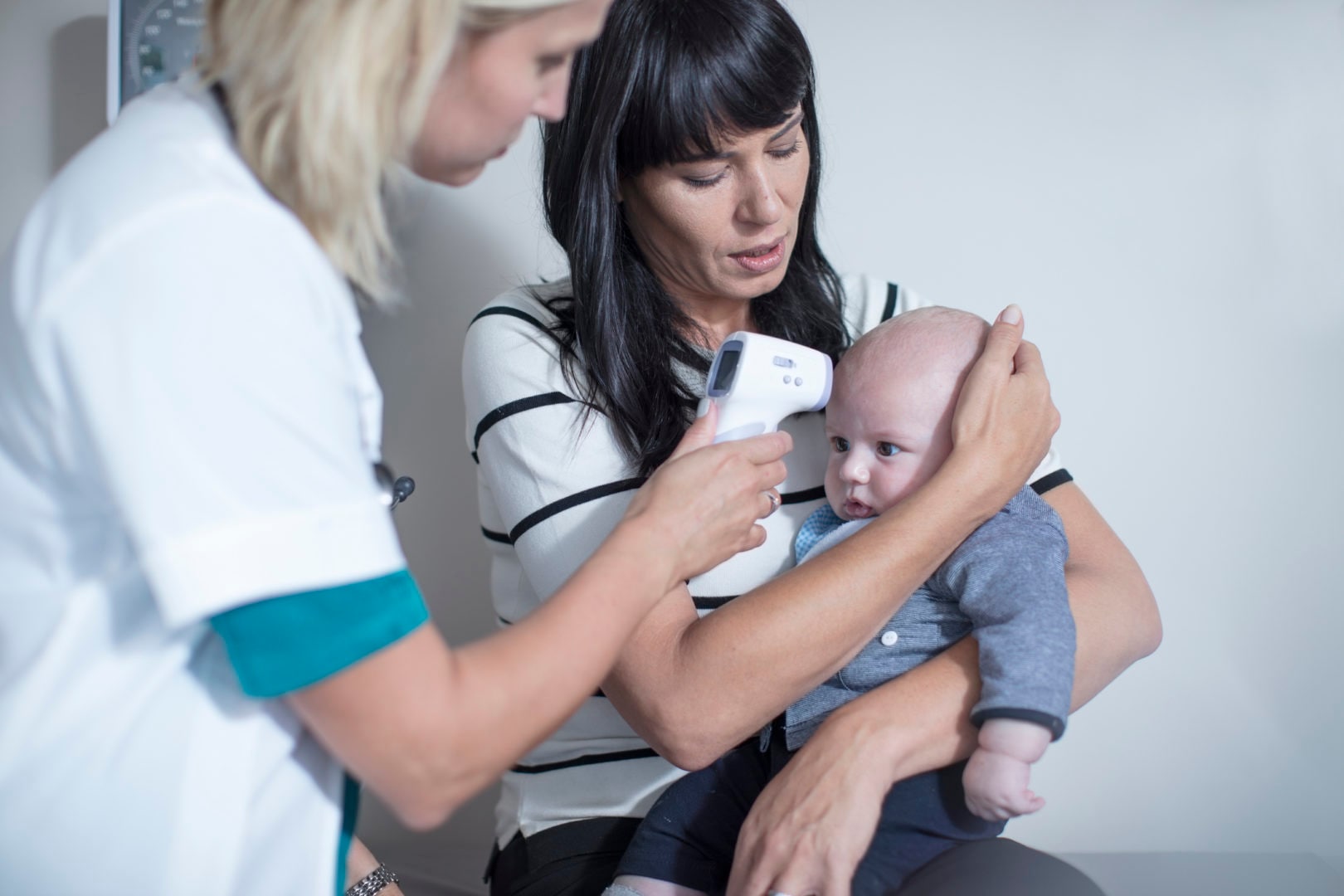They may be a common symptom of cold and flu viruses, but fevers in children have the ability to unnerve even the most experienced of parents and caretakers. But here’s some (emotional) comfort: A higher-than-normal temperature isn’t all bad.
“Fever is a well-designed, natural weapon that the body uses to fight off infections or inflammation,” says Dr. Brandon Smith, associate medical director of the Harriet Lane Clinic at Johns Hopkins in Baltimore. “An infection or inflammation in the body releases signals in the blood that tells the body to raise its temperature setting. The rise in temperature helps send out cells from the immune system to fight off infection or bring down inflammation in the body.”
“Fever is a well-designed, natural weapon that the body uses to fight off infections or inflammation.”
—Dr. Brandon Smith, pediatrician
All of that said, when the number on the thermometer continues to rise, it isn’t exactly easy to relax. Here, experts and parents weigh in on what to look for and what to do when a child comes down with a fever, along with tips on how to keep them comfortable — because you want to keep your cool when they’re hot.
What temperature is considered a fever in children?
Is 99.4 a fever in kids? What about 99.7? Not necessarily. According to Dr. Amna Husain, a pediatrician in Marlboro, New Jersey, a fever is any temperature above 100.4 degrees Fahrenheit (F) or 38 degrees Celsius (C).
“A lot of parents believe 99-100 F are fevers for kids, but these are considered normal variations of the body’s temperature — a true fever in children is 100.4 degrees F,” Husain explains. “While the average median core temperature is 98.6 F, normal temperature fluctuates throughout the day.”
What is the most accurate way to take a child’s temperature?
Something to keep in mind: When it comes to taking a child’s temperature, assessing their core (internal) temperature will yield more reliable results than outward skin temperature.
“Although there are a variety of methods for taking a child’s temperature, the most accurate ways are rectally in infants and young children and orally in older children,” says Smith. “Under the arm, on the forehead and simple touching are easy, but not great ways to measure temperatures.”
“Under the arm, on the forehead and simple touching are easy, but not great ways to measure temperatures.”
—Dr. Brandon Smith, pediatrician
When is a fever too high for a child?
While it may be tempting to compulsively check a child’s temperature when they’re not feeling well, how they’re acting and feeling, as well as the duration of the fever, is more important than the number on the thermometer.
The only absolute that a fever is too high and the doctor should be called immediately is when there’s a rectal temperature of 100.4 F or higher in infants 12 weeks of age or younger, as this may be a sign of a dangerous infection. “This is considered a medical emergency,” says Dr. Nick DeBlasio, a pediatrician at the Pediatric Primary Care Center at Cincinnati Children’s Hospital Medical Center in Cincinnati.
“For kids older than 12 weeks, there isn’t an exact temperature that warrants a medical evaluation, as so much of it depends on how the child is acting, what other symptoms they’re having and how long the fever has lasted.” If a child is generally feeling and acting OK, and no symptoms are present other than fever, DeBlasio likes to evaluate them within three days. “If they are acting sick or complain of other things, such as a sore throat, ear pain, poor urine output or breathing problems, I like to see them sooner,” he says.
It’s also worth noting that high fevers don’t cause brain damage. “Sometimes parents are worried that a higher fever may cause harm to the brain or death in their child. This isn’t true,” says Smith, who notes that a fever rarely — if ever — will go above 106 F. “Fevers don’t harm the body. Instead they help to fight off whatever infection or inflammation is happening.”
“Fever is a protective mechanism from the immune system. It’s a sign that the immune system is on to whatever pathogen the body is fighting.”
—Dr. Amna Husain, pediatrician
When should I take my child to the doctor for a fever?
Here’s when parents and caregivers should call the pediatrician for a fever, according to Smith:
- The child is under 3 months (12 weeks) of age and has a rectal temperature of 100.4 F or higher.
- The child shows very low energy, extreme tiredness and is not acting themselves.
- Fever has been going on for more than three days.
- Other symptoms are present, such as sore throat, vomiting, ear pain, belly pain or pain when urinating.
- The child is drinking less than usual and has had fewer than four wet diapers in a span of 24 hours or two urinations while they’re awake for the day.
- The child is having trouble breathing (this should warrant a call to the doctor whether or not a fever is present).
Other signs a child should be evaluated by their doctor, according to the American Academy of Pediatrics (AAP):
- The child has been in a very hot place, such as a car.
- A stiff neck, severe headache or unexplained rash are present.
- The child has immune system problems, such as cancer, or is taking steroids.
- A seizure has occurred.
- The child seems to be getting worse.
What is considered a fever: Child temperature chart
| Child’s age | When to see a doctor |
|---|---|
| Infants and babies (newborn – 3 mos.) | 100.4 degrees or higher |
| Babies (3 mos. +), as well as toddlers, big kids and teens | 100.4 degrees or higher AND any of the following: • Very low energy, extreme tiredness, not acting themselves. • Fever for 3+ days. • Other symptoms, such as sore throat, vomiting, ear pain, belly pain or pain when urinating. • Child is drinking less than usual and has fewer than four wet diapers in a span of 24 hours or two urinations while awake for the day. • The child is having trouble breathing. |
What causes fever?
Fevers are typically caused by infections from viruses (think cold and flu) or bacteria (think strep), according to the AAP. And the fever itself isn’t the illness, but instead a byproduct of the infection — and a good one at that.
“Fever is a protective mechanism from the immune system,” says Husain. “It’s a sign that the immune system is on to whatever pathogen the body is fighting.”
Other, less common, causes of fever in children, are:
- Immunizations. Some kids get a low-grade fever after getting a vaccination, according to the AAP.
- Overdressing. Infants, who don’t regulate body temperature as well as older kids, may get a fever if they’re dressed too warmly or are in a hot environment. (Even if you suspect this is the cause of fever, though, it’s imperative you call their doctor if they’re 12 weeks or younger.)
- Teething. Sometimes teething can result in a slight rise in body temperature, but typically it won’t cause a temperature over 100 F. “When any of my kids were teething, they always felt a little warmer than usual and had a faint rise in temperature,” says mom of two Alissa Davenport of Rochester, New York. “If they were running a little hot and drooling a ton, I usually knew it was teething.”
How to bring down a fever in a child
If a child has a fever but generally seems OK — they’re playing, eating and drinking and have their usual energy — the fever may not need to be treated. “As a pediatrician and a mother, I advocate treating a fever if the child is uncomfortable,” says Husain. “If they’re running around and playing as normal, why treat? On the other side of the spectrum, I’ve treated my daughter with Tylenol when she is ill with a viral process but fever-free to provide comfort and pain relief.”
“As a pediatrician and a mother, I advocate treating a fever if the child is uncomfortable.”
—Dr. Amna Husain
If a child is generally feeling crummy when they have a fever, either ibuprofen (only after 6 months of age) or acetaminophen can be used in appropriate doses. “Many pediatricians advise sticking to just one of these medications to make sure there’s no confusion and extra doses aren’t given,” says Smith.
Some parents and caregivers also like to use baths to help bring down a fever — which is OK, so long as the temperature is appropriate. “Sponging or using a washcloth can help a child feel better and bring down their temperature, but it’s important that the water is lukewarm and not cold,” notes Smith. “Cold baths or sponging with cold water will just cause your child to shiver and won’t help to make them feel better.”





